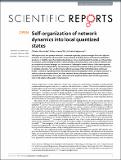Self-organization of network dynamics into local quantized states
Author(s)
Nicolaides, Christos; Juanes, Ruben; Cueto-Felgueroso, Luis
DownloadNicolaides-2016-Self-organization.pdf (1.020Mb)
PUBLISHER_CC
Publisher with Creative Commons License
Creative Commons Attribution
Terms of use
Metadata
Show full item recordAbstract
Self-organization and pattern formation in network-organized systems emerges from the collective activation and interaction of many interconnected units. A striking feature of these non-equilibrium structures is that they are often localized and robust: only a small subset of the nodes, or cell assembly, is activated. Understanding the role of cell assemblies as basic functional units in neural networks and socio-technical systems emerges as a fundamental challenge in network theory. A key open question is how these elementary building blocks emerge, and how they operate, linking structure and function in complex networks. Here we show that a network analogue of the Swift-Hohenberg continuum model—a minimal-ingredients model of nodal activation and interaction within a complex network—is able to produce a complex suite of localized patterns. Hence, the spontaneous formation of robust operational cell assemblies in complex networks can be explained as the result of self-organization, even in the absence of synaptic reinforcements.
Date issued
2016-02Department
Massachusetts Institute of Technology. Department of Civil and Environmental Engineering; Sloan School of ManagementJournal
Scientific Reports
Publisher
Nature Publishing Group
Citation
Nicolaides, Christos, Ruben Juanes, and Luis Cueto-Felgueroso. “Self-Organization of Network Dynamics into Local Quantized States.” Scientific Reports 6 (February 17, 2016): 21360.
Version: Final published version
ISSN
2045-2322